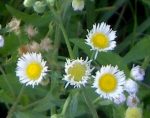 Annual fleabane is a herbaceous plant belonging to the aster family, Asteraceae, that also includes sunflower, yarrow, and lettuce. It is native to North American and can be found in most of the US especially in the eastern portion of its range. Plant prefer full to partial sun and moist soil but tolerate less and can be found in disturbed areas such as lawns, pastures, abandoned fields, vacant lots, waster areas, and along roadsides and railways.
Annual fleabane is a herbaceous plant belonging to the aster family, Asteraceae, that also includes sunflower, yarrow, and lettuce. It is native to North American and can be found in most of the US especially in the eastern portion of its range. Plant prefer full to partial sun and moist soil but tolerate less and can be found in disturbed areas such as lawns, pastures, abandoned fields, vacant lots, waster areas, and along roadsides and railways.
Description: Growing up to five feet tall from a thick long taproot, annual fleabane has erect purplish green stems that are branched at the to and have scattered stiff hairs. The ovate lower leaves are two to six inches long and coarsely toothed while the upper leaves are smaller, less toothed, and taper sharply at their base. The flower heads are 1/2 to 1″ wide and have 40 to 125 white to pale lavender ray flower surrounding yellow disc flowers. Flower heads appear from late spring to fall and give way to one seeded tufted fruits called achenes. Plants spread by wind disseminated seed.
Control: Because of its deep taproot and abundant seed production, annual fleabane is difficult to eradicate. Good soil management, dense planting of desirable plants, mechanical control measures, and herbicides may be necessary. Mulch to inhibit seed germination; pull or hoe seedlings as they appear and mow, dig, or pull larger plants before they set seed. In severe case apply a pre-emergent herbicide before plants emerge in the spring followed by a post-emergent herbicide when the plants are actively growing. Annual fleabane is resistant to many herbicides including glyphosates such as Roundup, but responds well to herbicides containing 2,4-D.